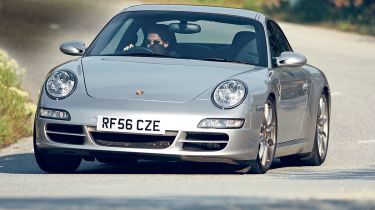Porsche 911 Carrera S Powerkit
Decades of development have perfected the 911’s rear-engine layout
After the drama and excitement of the extravagant R8, the 911 seems conservative and restrained. But as ever with Porsche, it’s engineering rather than design that sets this car apart.
The classic profile has been honed over decades of development and has proved successful, to the extent that the 911 is the runaway sales leader in this sector. But even though our car wore smart 19-inch Carrera Sport wheels, it was nowhere when it came to attracting attention on the roads.
A victim of its own success? Or perhaps it’s too versatile for its own good. Comparatively tall and narrow, it has a large glass area and slender, upright A-pillars. All-round visibility is the best here, and the 911 gains points because it has a light and airy cabin and a tight 10.9-metre turning circle.
A decent 135-litre front boot gives it an instant advantage over the R8, plus the 911 actually has rear seats – although admittedly these are best folded flat and treated as an extra stowage area. Unlike both British cars, there’s no tailgate access to this load area, but that doesn’t prevent the Porsche being the easiest car to live with day to day.
That’s not only down to its flexibility, but the fact it’s simple to get in and out of, plus the controls, switches, instruments and dials are logically laid out and operate precisely. Other useful touches, such as the cubbies in the door armrests and pop-out cup-holders, reinforce the impression that the 911 was designed to be used regularly.
But in the designers’ quest to make the 911 user-friendly, they seem to have forgotten to make it stylish. The cockpit doesn’t have the same sense of occasion as any of its rivals – chiefly because it has so much in common with the Boxster that costs half the price. And while the driving position is beyond criticism, the sports seats fitted to our test car are a £1,680 option – the normal chairs have less support.
Nor is the engine of our test car in standard trim. Fitted with the optional Powerkit, which features a modified cylinder head, new intake and exhaust manifolds, an uprated engine management system, carbon fibre air filter housing and a sports exhaust, it boasts an extra 26bhp. However, Porsche sees fit to charge £8,241 for this modest increase.
It’s a waste of money, since the 911’s 3.8-litre flat-six is so good in the first place. It must be said, though, that not even the R8 could match the Powerkit Porsche’s engine note, which develops from a bassy chatter to a high-rev wail.
Power outputs are nearly identical to the Aston’s, but due to the Porsche’s light weight and slippery shape, it proved as quick as the more potent Audi in most of our acceleration tests. Yet around bends it couldn’t keep pace. It suffered from a touch of understeer, but even so, we don’t think a four-wheel-drive version would have proved any faster.
Speed isn’t everything, though, and ultimately the 911 remained the most rewarding and enjoyable car to drive. The front end does move around over bumps and the steering twitches occasionally, but that’s just the car keeping you informed of what’s going on. It’s extremely positive to drive, with honed steering, stiff suspension and a very rigid structure.
Nevertheless, the dampers manage to absorb an enormous amount of punishment, although there’s no escaping the fact that the comparatively unrefined 911 is a noisy cruiser. Not to mention the fact it’s very poorly kitted out in standard trim.
Details
Price: £76,101
Model tested: Porsche 911 Carrera S P’kit
Chart position: 2
WHY: Tested here with the optional Powerkit, the 911 isn’t ready to relinquish its crown just yet.
Economy
Unlike the Audi and Jaguar, the Porsche isn’t built from aluminium. But it’s still the lightest car of our quartet, which helps it return 20.2mpg – the best figure on test.
Residuals
The Powerkit adds around 15p per mile to the price of 911 ownership, taking it to nearly £1.80 a mile. Yet even without it, this isn’t a cheap car to run, despite strong residuals.
Servicing
Porsche only provides a miserly two-year warranty, but you can cover 20,000 miles between services. That’s just as well, as the first three come to nearly £1,500.
Tax
A major part of contract hire calculations is depreciation – a 911 strength. Yet the Porsche is still more costly than the Jag. At least the £1,490 total takes in servicing.







